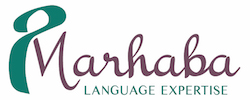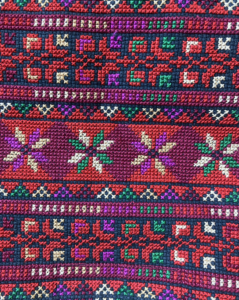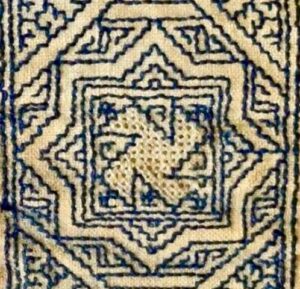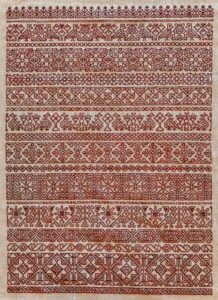Embroidery and the Region
In this post, I’m delighted to introduce you to some embroidery textile arts happening today and some of the people who are currently at work in these fields in the SWANA/MENA region (Southwest Asia and North Africa/Middle East and North Africa). We’ll be looking at Palestinian, Egyptian, and Moroccan examples, in that order. This post is not comprehensive – feel free to contact me if I’ve failed to include a person or topic you’d like me to add!
Embroidery
Over the past several years, I’ve been exploring embroidery from Arabic-speaking regions. The most prominent and most publicized worldwide, in my experience, is Palestinian embroidery, termed tatreez / تطريز
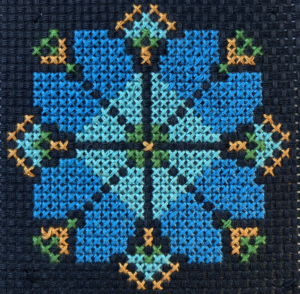
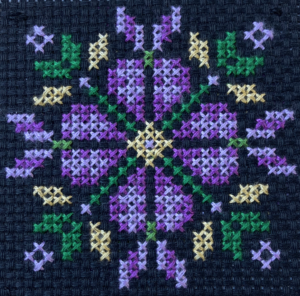
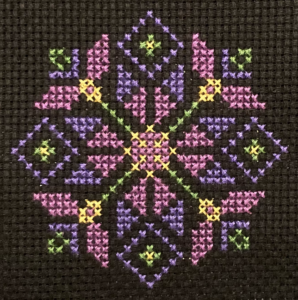
Palestinian Embroidery
Palestinian embroidery is distinguished by its politicization (given the ongoing conflict in Israel/Palestine and resulting diasporas). It’s also distinctive because it is entirely composed of the cross-stitch technique (meaning, stitches in the shape of an “x”). There are probably some exceptions, but they are exceptions to an otherwise very regular rule.
In the English-language universe of the internet, Tatreez & Tea is the most prominent and accessible resource for learning about Palestinian embroidery, including its history, contemporary social contexts, and techniques. Tatreez & Tea is run by Wafa Ghnaim, the Collections Specialist at The Museum of the Palestinian People and the “first-ever Palestinian embroidery instructor at the Smithsonian Museum” (source). She also conducts research at The Metropolitan Museum of Art on Syrian and Palestinian textiles. She has an upcoming online class on Syrian cross-stitch embroidery (see here), as part of the World Embroidery Series.
For another artist and to purchase Palestinian embroidery, see: @tatreez_home_decor . Also the PalestinePartners Etsy shop. For a UK option, see this shop. For an interview with Rula Alami, see here. She’s vice president of INAASH embroidery association in Beirut, as well as an art collector and curator.
For more about the history of Palestinian embroidery, see the Masters thesis of Margaret Deppe here.
I learned a lot about Palestinian embroidery when I wrote my thesis. Many of the patterns date to the 13th century/Mamluk empire!
Margaret Deppe
Egyptian Embroidery
Egyptian embroidery, in contrast to its Palestinian cousin, is hardly known at all. Partly this is because khayamiyya receives the focus of interest in traditional textile arts in Egypt. There is embroidery (also called tatreez) in Egypt, of course. For example, see this 2017 article on embroidery in Upper Egypt (southern Egypt). It is also mentioned in Bassiouney’s new historical trilogy, Al-Qata’i.
However, it is not publicized. Fortunately for those who would like to learn Egyptian embroidery techniques, Madeleine Picciotto’s “Cliffside Stitches” provides patterns inspired by historical sources. Her renditions of Egyptian Blackwork are based on “medieval Egyptian textile fragments (10th-15th century) from the Ashmolean Museum in Oxford, UK,” as stated in the description of a pattern in her Etsy shop.
When I asked her about stitch types in Egyptian embroidery, she explained, “Although my most recent Egyptian-inspired designs focus on motifs done in running stitch (a technique familiar to modern stitchers as “blackwork”), medieval Egyptian embroidery also used cross stitch, pattern darning, and other techniques. In fact, I have a design (“Egyptian Sampler”) that was inspired by the cross stitch motifs from the medieval Egyptian textiles at the Ashmolean, and I’m currently working on a design that features pattern darning. Designs similar to the medieval Egyptian motifs — in cross stitch and running stitch — have also been found in Lebanon: in particular, in a set of textiles from a 13th-century burial site in the Qadisha Valley of Northern Lebanon.” To learn more about blackwork, consider this online class (including hands-on making) coming up in a week: Blackwork Embroidery.
About her work, she adds, “I’ve been designing embroidery patterns for myself for decades, mostly because I love stitching but don’t like many of the modern patterns that are widely distributed. I didn’t “go public” with my patterns until 2020, when I opened my Etsy shop. I’m very interested in the global history of needlework, and my designs are inspired by traditional motifs from around the world. I especially want today’s stitchers to be exposed to embroidery traditions from regions that haven’t received as much attention in the modern stitching community. But I don’t claim to be producing accurate replicas of traditional designs; I adapt, modify, embellish, and combine the traditional elements to produce a design that I think will speak to modern stitchers while still capturing the spirit of the traditional sources.”
To follow up in the library, see Marianne Ellis’s Embroideries & Samplers from Islamic Egypt and Gillian Vogelsang-Eastwood’s Encyclopedia of Embroidery from the Arab World.
Moroccan Embroidery
As for Moroccan embroidery, it is known as al-tarz al-maghribi (or al-tarz al-Fasi or whatever region is being discussed). It’s also frequently spoken of in French, referred to as broderie. It includes several stitch types. The premier English-language source on technique I’ve found is Introduction to Fessi Embroidery by Margaret A. Deppe. Currently available on Amazon Kindle here. The author plans to provide a print-on-demand paperback option there soon.
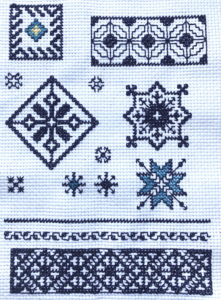
Margaret Deppe has extensive experience in textiles, costuming for various kinds of dance and writing her above-mentioned MS thesis on the motifs used in Fellahi embroidery (“generally known as Palestinian cross stitch, but the technique is also used in what is now Syria and the Sinai Peninsula/Egypt among non-Palestinians in the Levant,” she explains). As for her experience with Moroccan embroidery, she picked it up in a trip to Morocco in 2007 and hopes to return next year.
For an overview of different styles of Moroccan embroidery (in Arabic), see here. For those interested in purchasing premium embroidered textiles from Morocco, check out AlNour Textiles in Marrakech. AlNour also partners with exclusive shops such as The Metropolitan Museum of Art (learn more here). Made by handicapped artisan women.
There is certainly embroidery in the MENA/SWANA region that is not covered here. For example, there is Jordanian embroidery (see here). Another reference for those who’d like to follow up in the library: Encyclopedia of Embroidery from the Arab World book review on AramcoWorld here. If you’d like to share more about textile arts in this region, contact me or add to the conversation on any of my social media channels. And don’t forget the upcoming World Embroidery Series: A 6-Week Exploration classes with hands-on learning opportunities!
